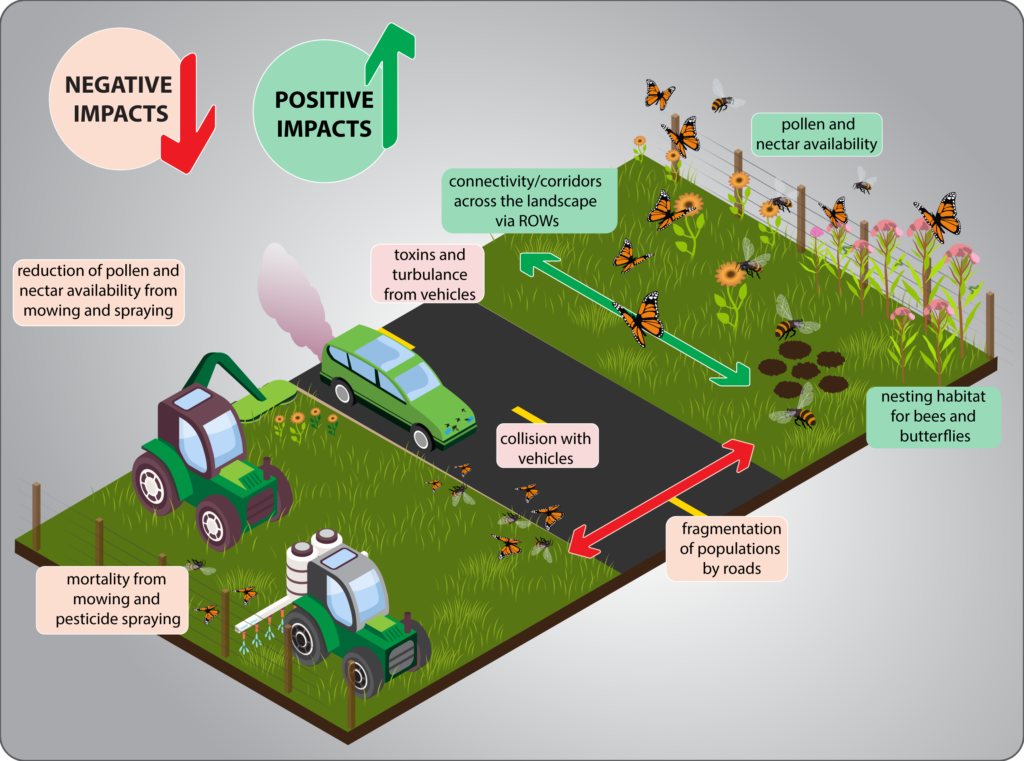Monarch butterflies (Danaus plexippus), the striking and iconic orange and black insects of postcards and motivational posters, have been in population decline since the 1980s and Thomas Meinzen, a master’s student in Montana State University’s Ecology Department, turned to a largely overlooked environment to save them. His thesis, Bees and Butterflies in Roadside Habitats: Identifying Patterns, Protecting Monarchs, and Informing Management, investigated the value of highway rights-of-way (ROWs) for pollinator, especially monarch, conservation. Supported by the Idaho Transportation Department (ITD), the project evaluated undeveloped land that parallels many roads for its potential to sustain western US monarch migrations and determined the variety of other pollinator species that used its native and non-native plants.
Thomas was advised by MSU Ecology Department Head, Dr. Diane Debinski, a butterfly specialist, in partnership with fellow ecology professor Dr. Laura Burkle, a bee specialist, and WTI’s Road Ecology Program Manager, Rob Ament. He surveyed 910 miles of southeast Idaho highways for the presence of monarchs and identified the number and location of showy milkweed patches (Asclepias speciosa – the obligate host plant of monarch larva). Thomas also noted the abundance and variety of other butterflies, bees, and native and non-native plants found in the roadside habitats.
The researchers were surprised to find that showy milkweed was quite common along SE Idaho highways, while monarch butterfly numbers had decreased alarmingly in 2021 and 2022. They were also surprised that bee variety and quantity was higher in secondary highway roadsides compared to primary and interstate ROWs, as well as areas dominated by native plants.
“Our study found that areas with diverse native flora and sagebrush steppe, in particular,” said Dr. Debinski, “had significantly higher bee richness and abundance than other sites.” At the same time, the abundance of butterflies depended almost entirely on the number of flowering plants, native or not.
The field study also developed roadside management recommendations to help insects overcome the downside of living and breeding in the ROWs. “Collisions with vehicles, pollutants, herbicides, insecticides, and disturbance caused by management practices were all hazards associated with bee and butterfly use of roadsides,” explained Dr. Debinski. “One of the goals of this research was to understand the best way to manage those areas for pollinators.” This is particularly true for monarchs, which are experiencing critically low population numbers, cannot afford to lay eggs or have their larva feed on plants that will be cut or sprayed in the middle of their lifecycle.
“Bees and Butterflies in Roadside Habitats” expressed concern that roadside habitats could become traps, luring pollinators in with healthy ecosystems and then collapsing population numbers through highway management practices or pollution. To avoid creating a population sink, the report recommended a suite of good practices, from protecting all roadside milkweed patches from herbicides and mowing, mowing smaller portions of the ROW with less frequency and never after flowering, and using pollinator-safe mowers, to spot treating weeds rather than applying herbicides to the entire roadside.
Overall, the research revealed that land along southeast Idaho highways, particularly those with lower traffic levels, was supporting a wide variety of pollinators and could provide an important role in pollinator conservation. “This is one of those areas in road ecology that is finally receiving the attention it is due, particularly given 85% of all agricultural crops require pollinators,” commented Rob Ament.
However, further research is required. “We need to figure out if roadsides are contributing to pollinator population growth or decline overall,” noted Dr. Debinski. “Future research should also determine whether roadside habitats act as corridors for pollinator dispersal; a catchy idea, but one that needs support from more data.”

